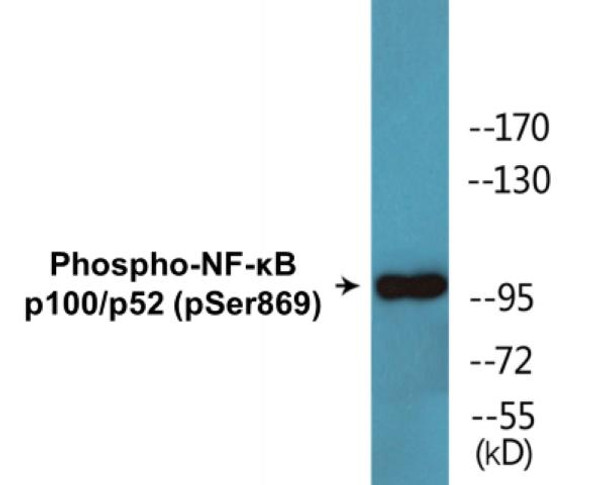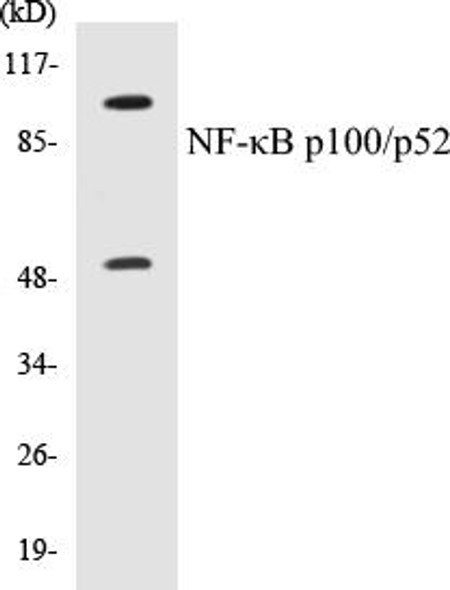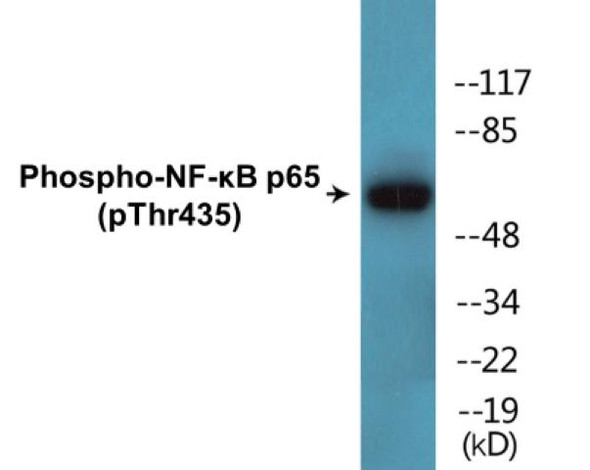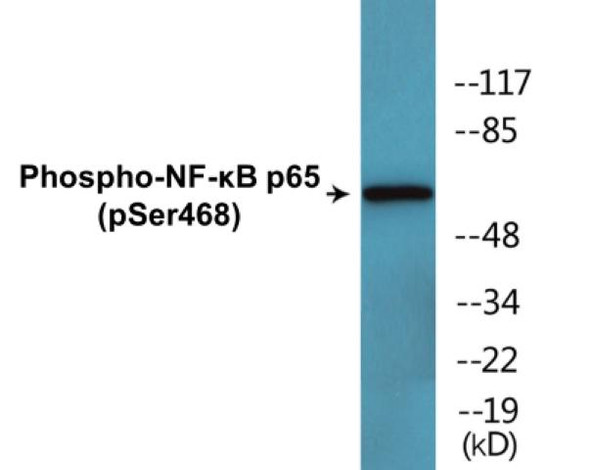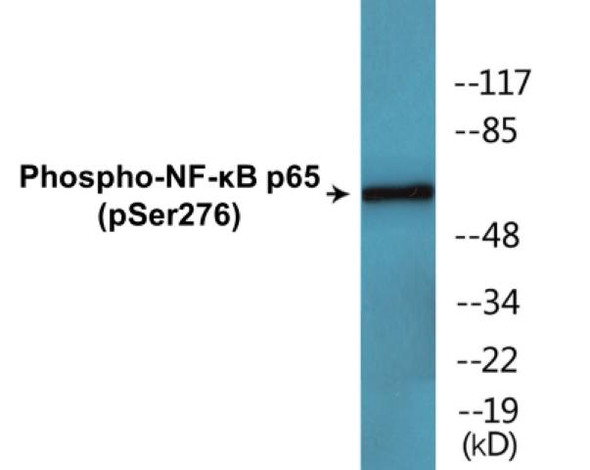NF-kappaB p100/p52 (Phospho-Ser869) Colorimetric Cell-Based ELISA Kit
- SKU:
- CBCAB01575
- Product Type:
- ELISA Kit
- ELISA Type:
- Cell Based Phospho Specific
- Research Area:
- Cell Biology
- Reactivity:
- Human
- Mouse
- Rat
- Detection Method:
- Colorimetric
Description
NF-kappaB p100/p52 (Phospho-Ser869)Colorimetric Cell-Based ELISA Kit
The Human NF-kappaB p100/p52 (Phospho-Ser869) Colorimetric Cell-based ELISA Kit is a powerful tool for measuring the levels of phosphorylated NF-kappaB p100/p52 protein in cell lysates. This kit provides high sensitivity and specificity, ensuring accurate and reproducible results for your research needs.NF-kappaB p100/p52 is a critical transcription factor involved in regulating immune responses, inflammation, and cell survival. The phosphorylation of NF-kappaB p100/p52 at Ser869 is an important post-translational modification that can modulate its activity and function. By measuring the levels of phosphorylated NF-kappaB p100/p52 in cell lysates, researchers can gain valuable insights into the signaling pathways and cellular processes regulated by this protein.
This NF-kappaB p100/p52 (Phospho-Ser869) ELISA Kit is suitable for studying various biological processes, including inflammation, cancer, and autoimmune diseases. Its ease of use and reliability make it a valuable asset for any laboratory conducting research on NF-kappaB signaling pathways. Get your kit today and unlock the potential of NF-kappaB p100/p52 phosphorylation in your research.
| Product Name: | NF-kappaB p100/p52 (Phospho-Ser869) Colorimetric Cell-Based ELISA |
| Product Code: | CBCAB01575 |
| ELISA Type: | Cell-Based |
| Target: | NF-kappaB p100/p52 (Phospho-Ser869) |
| Reactivity: | Human, Mouse, Rat |
| Dynamic Range: | > 5000 Cells |
| Detection Method: | Colorimetric 450 nm |
| Format: | 2 x 96-Well Microplates |
The NF-kappaB p100/p52 (Phospho-Ser869) Colorimetric Cell-Based ELISA Kit is a convenient, lysate-free, high throughput and sensitive assay kit that can detect NF-kB p100/p52 protein phosphorylation and expression profile in cells. The kit can be used for measuring the relative amounts of phosphorylated NF-kB p100/p52 in cultured cells as well as screening for the effects that various treatments, inhibitors (ie. siRNA or chemicals), or activators have on NF-kB p100/p52 phosphorylation.
Qualitative determination of NF-kappaB p100/p52 (Phospho-Ser869) concentration is achieved by an indirect ELISA format. In essence, NF-kappaB p100/p52 (Phospho-Ser869) is captured by NF-kappaB p100/p52 (Phospho-Ser869)-specific primary (1ø) antibodies while the HRP-conjugated secondary (2ø) antibodies bind the Fc region of the 1ø antibody. Through this binding, the HRP enzyme conjugated to the 2ø antibody can catalyze a colorimetric reaction upon substrate addition. Due to the qualitative nature of the Cell-Based ELISA, multiple normalization methods are needed:
| 1. | A monoclonal antibody specific for human GAPDH is included to serve as an internal positive control in normalizing the target absorbance values. |
| 2. | Following the colorimetric measurement of HRP activity via substrate addition, the Crystal Violet whole-cell staining method may be used to determine cell density. After staining, the results can be analysed by normalizing the absorbance values to cell amounts, by which the plating difference can be adjusted. |
| Database Information: | Gene ID: 4791, UniProt ID: Q00653, OMIM: 164012, Unigene: Hs.73090 |
| Gene Symbol: | NFKB2 |
| Sub Type: | Phospho |
| UniProt Protein Function: | NFkB-p100: a transcription factor of the nuclear factor-kappaB ( NFkB) group. Precursor of the p52 subunit of the nuclear factor NF-kappa-B, which binds to the kappa-B consensus sequence 5'-GGRNNYYCC-3', located in the enhancer region of genes involved in immune response and acute phase reactions. The precursor protein itself does not bind to DNA. LT-beta receptor agonists and LPS induce NF-kappaB/p100 processing to p52 at the level of the ribosome. There are five NFkB proteins in mammals (RelA/NFkB-p65, RelB, c-Rel, NF-_B1/NFkB-p105, and NF-_B2/NFkB-p100). They form a variety of homodimers and heterodimers, each of which activates its own characteristic set of genes. Two spliced isoforms have been identified. Isoform p49 is a subunit of the NF-kappa-B protein complex, which stimulates the HIV enhancer in synergy with p65. |
| UniProt Protein Details: | Protein type:Transcription factor; Oncoprotein; DNA-binding Chromosomal Location of Human Ortholog: 10q24 Cellular Component: Bcl3/NF-kappaB2 complex; nucleoplasm; cytoplasm; nucleus; cytosol Molecular Function:protein binding; transcription coactivator activity; chromatin binding; transcription factor activity Biological Process: spleen development; I-kappaB kinase/NF-kappaB cascade; extracellular matrix organization and biogenesis; transcription, DNA-dependent; follicular dendritic cell differentiation; MyD88-independent toll-like receptor signaling pathway; rhythmic process; toll-like receptor 3 signaling pathway; negative regulation of transcription from RNA polymerase II promoter; toll-like receptor 10 signaling pathway; activation of NF-kappaB transcription factor; toll-like receptor 2 signaling pathway; MyD88-dependent toll-like receptor signaling pathway; toll-like receptor 5 signaling pathway; regulation of transcription, DNA-dependent; response to cytokine stimulus; toll-like receptor signaling pathway; germinal center formation; positive regulation of interferon type I production; innate immune response; positive regulation of transcription from RNA polymerase II promoter; toll-like receptor 9 signaling pathway; inflammatory response; toll-like receptor 4 signaling pathway Disease: Immunodeficiency, Common Variable, 10 |
| NCBI Summary: | This gene encodes a subunit of the transcription factor complex nuclear factor-kappa-B (NFkB). The NFkB complex is expressed in numerous cell types and functions as a central activator of genes involved in inflammation and immune function. The protein encoded by this gene can function as both a transcriptional activator or repressor depending on its dimerization partner. The p100 full-length protein is co-translationally processed into a p52 active form. Chromosomal rearrangements and translocations of this locus have been observed in B cell lymphomas, some of which may result in the formation of fusion proteins. There is a pseudogene for this gene on chromosome 18. Alternative splicing results in multiple transcript variants. [provided by RefSeq, Dec 2013] |
| UniProt Code: | Q00653 |
| NCBI GenInfo Identifier: | 116242678 |
| NCBI Gene ID: | 4791 |
| NCBI Accession: | Q00653.4 |
| UniProt Secondary Accession: | Q00653,Q04860, Q9BU75, Q9H471, Q9H472, A8K9D9, D3DR83 |
| UniProt Related Accession: | Q00653,AAB23437 |
| Molecular Weight: | 900 |
| NCBI Full Name: | Nuclear factor NF-kappa-B p100 subunit |
| NCBI Synonym Full Names: | nuclear factor of kappa light polypeptide gene enhancer in B-cells 2 (p49/p100) |
| NCBI Official Symbol: | NFKB2 |
| NCBI Official Synonym Symbols: | p52; p100; H2TF1; LYT10; CVID10; LYT-10; NF-kB2 |
| NCBI Protein Information: | nuclear factor NF-kappa-B p100 subunit; oncogene Lyt-10; NFKB, p52/p100 subunit; DNA-binding factor KBF2; transcription factor NFKB2; nuclear factor Kappa-B, subunit 2; nuclear factor NF-kappa-B p52 subunit; lymphocyte translocation chromosome 10 protein; nuclear factor of Kappa light chain gene enhancer in B cells 2 |
| UniProt Protein Name: | Nuclear factor NF-kappa-B p100 subunit |
| UniProt Synonym Protein Names: | DNA-binding factor KBF2; H2TF1; Lymphocyte translocation chromosome 10 protein; Nuclear factor of kappa light polypeptide gene enhancer in B-cells 2; Oncogene Lyt-10; Lyt10 |
| Protein Family: | Nuclear factor |
| UniProt Gene Name: | NFKB2 |
| UniProt Entry Name: | NFKB2_HUMAN |
| Component | Quantity |
| 96-Well Cell Culture Clear-Bottom Microplate | 2 plates |
| 10X TBS | 24 mL |
| Quenching Buffer | 24 mL |
| Blocking Buffer | 50 mL |
| 15X Wash Buffer | 50 mL |
| Primary Antibody Diluent | 12 mL |
| 100x Anti-Phospho Target Antibody | 60 µL |
| 100x Anti-Target Antibody | 60 µL |
| Anti-GAPDH Antibody | 60 µL |
| HRP-Conjugated Anti-Rabbit IgG Antibody | 12 mL |
| HRP-Conjugated Anti-Mouse IgG Antibody | 12 mL |
| SDS Solution | 12 mL |
| Stop Solution | 24 mL |
| Ready-to-Use Substrate | 12 mL |
| Crystal Violet Solution | 12 mL |
| Adhesive Plate Seals | 2 seals |
The following materials and/or equipment are NOT provided in this kit but are necessary to successfully conduct the experiment:
- Microplate reader able to measure absorbance at 450 nm and/or 595 nm for Crystal Violet Cell Staining (Optional)
- Micropipettes with capability of measuring volumes ranging from 1 µL to 1 ml
- 37% formaldehyde (Sigma Cat# F-8775) or formaldehyde from other sources
- Squirt bottle, manifold dispenser, multichannel pipette reservoir or automated microplate washer
- Graph paper or computer software capable of generating or displaying logarithmic functions
- Absorbent papers or vacuum aspirator
- Test tubes or microfuge tubes capable of storing ≥1 ml
- Poly-L-Lysine (Sigma Cat# P4832 for suspension cells)
- Orbital shaker (optional)
- Deionized or sterile water
*Note: Protocols are specific to each batch/lot. For the correct instructions please follow the protocol included in your kit.
| Step | Procedure |
| 1. | Seed 200 µL of 20,000 adherent cells in culture medium in each well of a 96-well plate. The plates included in the kit are sterile and treated for cell culture. For suspension cells and loosely attached cells, coat the plates with 100 µL of 10 µg/ml Poly-L-Lysine (not included) to each well of a 96-well plate for 30 minutes at 37 °C prior to adding cells. |
| 2. | Incubate the cells for overnight at 37 °C, 5% CO2. |
| 3. | Treat the cells as desired. |
| 4. | Remove the cell culture medium and rinse with 200 µL of 1x TBS, twice. |
| 5. | Fix the cells by incubating with 100 µL of Fixing Solution for 20 minutes at room temperature. The 4% formaldehyde is used for adherent cells and 8% formaldehyde is used for suspension cells and loosely attached cells. |
| 6. | Remove the Fixing Solution and wash the plate 3 times with 200 µL 1x Wash Buffer for five minutes each time with gentle shaking on the orbital shaker. The plate can be stored at 4 °C for a week. |
| 7. | Add 100 µL of Quenching Buffer and incubate for 20 minutes at room temperature. |
| 8. | Wash the plate 3 times with 1x Wash Buffer for 5 minutes each time. |
| 9. | Add 200 µL of Blocking Buffer and incubate for 1 hour at room temperature. |
| 10. | Wash 3 times with 200 µL of 1x Wash Buffer for 5 minutes each time. |
| 11. | Add 50 µL of 1x primary antibodies Anti-NF-kappaB p100/p52 (Phospho-Ser869) Antibody, Anti-NF-kappaB p100/p52 Antibody and/or Anti-GAPDH Antibody) to the corresponding wells, cover with Parafilm and incubate for 16 hours (overnight) at 4 °C. If the target expression is known to be high, incubate for 2 hours at room temperature. |
| 12. | Wash 3 times with 200 µL of 1x Wash Buffer for 5 minutes each time. |
| 13. | Add 50 µL of 1x secondary antibodies (HRP-Conjugated AntiRabbit IgG Antibody or HRP-Conjugated Anti-Mouse IgG Antibody) to corresponding wells and incubate for 1.5 hours at room temperature. |
| 14. | Wash 3 times with 200 µL of 1x Wash Buffer for 5 minutes each time. |
| 15. | Add 50 µL of Ready-to-Use Substrate to each well and incubate for 30 minutes at room temperature in the dark. |
| 16. | Add 50 µL of Stop Solution to each well and read OD at 450 nm immediately using the microplate reader. |
(Additional Crystal Violet staining may be performed if desired – details of this may be found in the kit technical manual.)

